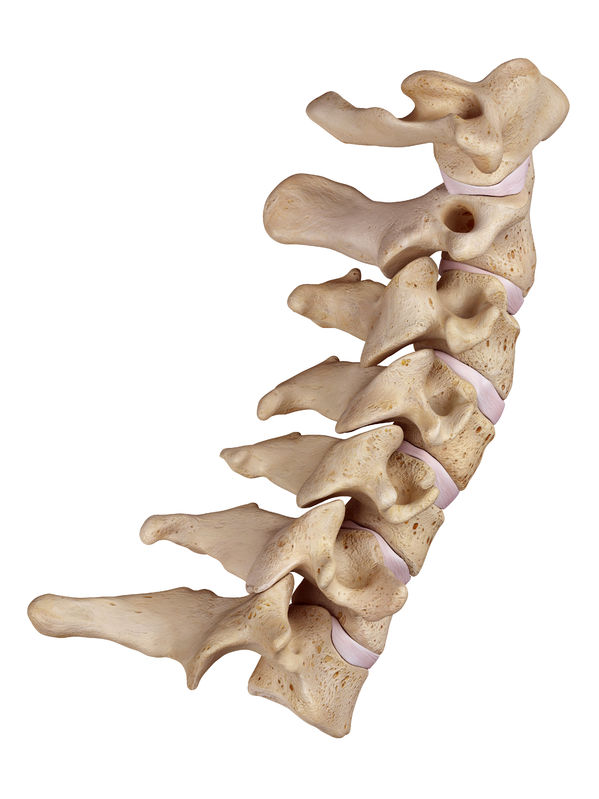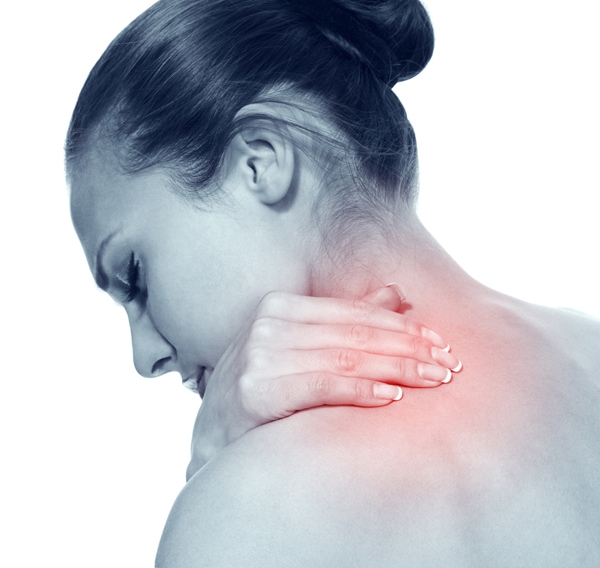Physical therapist, Dr. Klaus Dobra, PT, DPT, CSCS, discusses the structure of the cervical spine and suggests exercises you can use to avoid neck pain.
In order to understand the importance of treating cervical pain, it is important to first understand the anatomy, etiology, and epidemiology of the condition.
‘[Cervical] pain is the fourth leading cause of disability, with an annual prevalence rate exceeding 30%. Most episodes of acute neck pain will resolve with or without treatment, but nearly 50% of individuals will continue to experience some degree of pain or frequent occurrences.’

Anatomy of the Cervical Spine
The cervical spine is composed of seven vertebrae with cartilaginous disc separating each one. Because these vertebrae are free of attachment except to one another, and because they lack significant muscle girth to support them, the cervical spine is an impressively mobile structure. That mobility, however, comes at a significant cost; susceptibility to injury. Some major causes of pain and dysfunction are: traumatic injury or accident, degenerative disorders of cervical discs and facet joints (i.e.osteoarthritis, rheumatoid arthritis), and, most commonly, posture.
Exercises to Combat Cervical Spine Injuries
In order to combat normal changes throughout the lifespan that we ultimately cannot prevent, and the abnormal ones that we ultimately can, it is important to understand the role that exercise plays. Ultimately, exercise aims to improve cervical posture. Good posture refers to good alignment, and good alignment refers to the least stressful position of the body. With regards to the cervical spine, it is the position of those seven stacked vertebrae relative to one another. Intuitively then, the following exercises aim to fortify ‘neutral cervical posture’ and maintain, through muscle activation and strengthening, ‘good alignment.’
Chin Tucks
Weakness in deep cervical flexors contributes to forward head posture, so strengthening this muscle group is integral in improving posture and relieving pain. The most direct way to target this muscle group is through chin tucks. This exercise can be performed in seated or standing to eliminate the resistance imposed by gravity, or in prone(i.e. on your stomach) or quadruped (i.e. on hands and knees) in order to add the resistance of gravity.
Standing Position
Quadraped Position
Scapular Squeezes
Weakness of scapular retractors contributes to forward rounded shoulders and hyperextension of the cervical spine, so strengthening them is equally important. The most direct way to strengthen these muscles is through exercises that engage those scapular retractors through scapular squeezes which can be performed in seated or standing as stated above, or in prone to increase resistance and scapular load.
Seated Position
Prone Position
Dead Bug & Bird-Dog
Weakness of the core is one of the biggest contributors to cervical strain and impaired posture because the core has the most important role in spinal alignment. If the lumbar and thoracic spinal posture is compromised, the result is flexion of that segment of the spine, and hyperextension of the cervical spine in order to accommodate. Therefore, core strengthening exercises with emphasis on ‘neutral spine’ such as dead bug in supine (i.e. on your back) and bird-dog in quadruped are important for a more comprehensive routine.
Dead Bug
Bird-Dog
Foam Rolling and Stretches
Tightness in the pectorals further contribute to forward rounded shoulders and compromised cervical posture. Therefore, a regimen of stretching these muscle groups that can be done in supine, on a foam roller, and with a standing doorway stretch.
Pec Stretch Standing
Pec Stretch on Foam Roller
The Importance of Proper Posture
The most important exercise you should consider for cervical health and longevity is improving your posture throughout the day, particularly with prolonged periods of sitting that plagues the modern workforce.
Good posture in a seated position includes maintaining the natural curve of the lumbar spine by making sure you are resting on your ‘sits bones’ and have good lumbar support, as well as maintaining scapular retraction that subsequently preserves the natural curves of thoracic and lumbar spines. Without the implementation of good posture to reinforce what the above exercises hope to fortify, all of that hard work will be for naught.
Putting It All Together
Ultimately, it is our responsibility to combat the forces of gravity and the physical stresses of life with exercises and postural awareness. If we increase our mindfulness with regards to these principles, we can prevent the potentially debilitating role that pain serves. At Physio Logic, our goal is always to treat the ‘self’ in it’s entirety. If you are experiencing cervical pain, come visit our team of providers who will work intelligently and work together to help you stand a little taller without that nagging pain in your neck.
